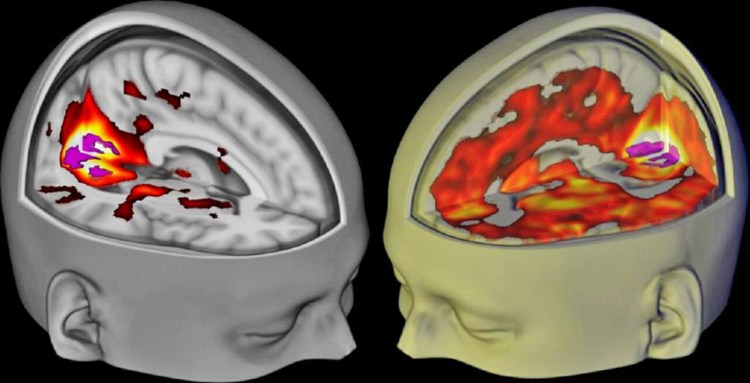Forget the old egg-in-a-frying pan bit – scientists finally know what your brain really looks like on drugs.
A team of British-based researchers have conducted the first brain scans of people under the effects of LSD. They published their results this week in the Proceedings of the National Academy of Sciences.
The drug, administered via IV, led to major changes in how different components of the brain interacted. “Normally our brain consists of independent networks that perform separate specialized functions, such as vision, movement and hearings, as well as more complex things like attention,” study co-author Robin Carhart-Harris of the Imperial College London explained in a statement. “However, under LSD the separateness of these networks breaks down and instead you see a more integrated or unified brain.”
They also found that under LSD, many different areas of the brain contributed to the processing of visual information. Usually, that activity is only focused in the so-called visual cortex. That finding goes a long way to explain why so many people under the effects of LSD report seeing vivid, dream-like hallucinations – even with their eyes closed.
The research could help pave the way for treatments for a variety of mental disorders, like addiction and depression. “In many psychiatric disorders, the brain may be viewed as having become entrenched in pathology such that core behaviors become automated and rigid,” the study concludes. “Consistent with their dysregulating effect on cortical activity, psychedelics may work to breakdown such disorders by dismantling the patterns of activity on which they rest.”
A growing body of research suggests that LSD, when taken in a strictly regulated fashion, may carry beneficial affects for health and well-being. The Beckley Foundation, one of the groups funding the LSD imaging study, recently called for the legalization and regulation of LSD and other psychedelic drugs for precisely this reason.
But research into the potential uses of LSD and similar drugs has been stymied by strict federal prohibitions. The Drug Enforcement Administration considers LSD a Schedule 1 drug, meaning it has “no currently accepted medical use and a high potential for abuse.” As with marijuana, federal prohibition puts LSD research into something of a Catch-22: The drug is so strictly regulated because it has no accepted medical use, and it has no accepted medical use because strict regulations prevent most research. It’s no accident that the LSD imaging study happened under the auspices of a British research university rather than an American one.
LSD is also similar to marijuana in that fatal overdoses on the drug are rare to non-existent. Given the relative lack of toxicity and the potential for therapeutic use, federal policies on LSD have fallen increasingly out-of-step with science in the decades since the Controlled Substances Act was first passed.
By starting to untangle the mysteries of what actually happens in a brain under the effects of LSD, the researchers hope to open the door to further research, and deeper understanding of the drug’s potential risks and benefits. And their findings may shed some light on even loftier questions, such as the nature of consciousness itself.
Noting the “altered state of consciousness that people often describe during an LSD experience,” study author Carhart-Harris said in a statement that “our results suggest that this effect … is also related to what people sometimes call ‘ego-dissolution,’ which means the normal sense of self is broken down and replaced by a sense of reconnection with themselves, others and the natural world.”
In an interview with the Guardian, David Nutt, Britain’s former drug czar and a lead researcher on the study, was blunt in his assessment of the importance of the findings. “This is to neuroscience what the Higgs boson was to particle physics,” he said.
Send questions/comments to the editors.


